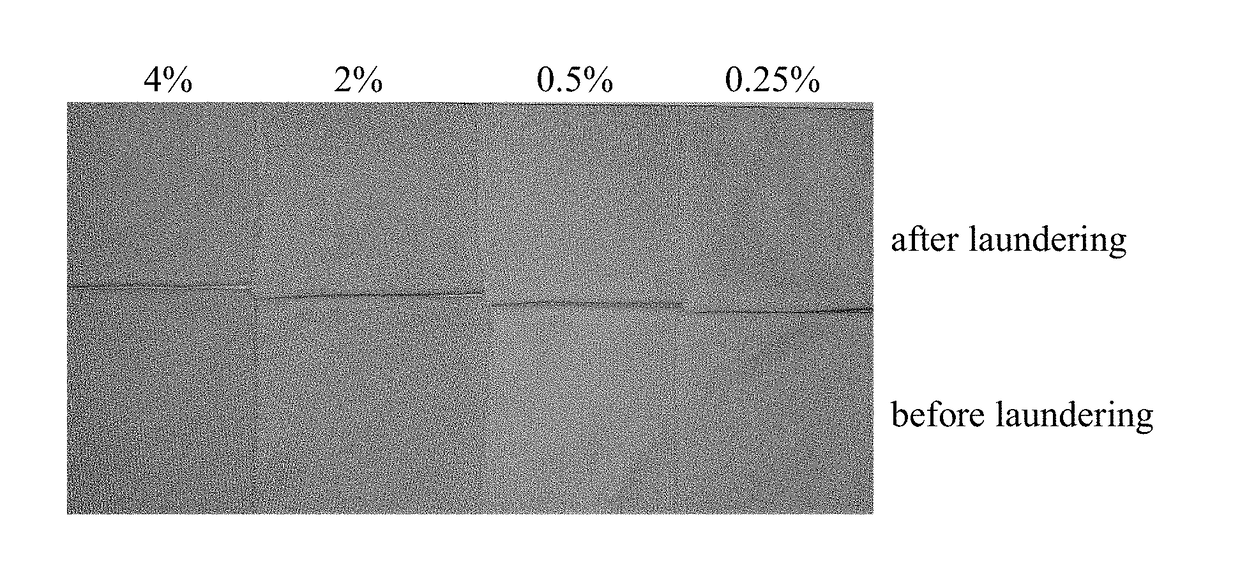Biocompatible and biodegradable natural disperse dyes for dyeing polyester fabrics
a natural disperse dye, biocompatible technology, applied in the direction of organic dyes, azo dyes, chemistry apparatus and processes, etc., can solve the problems of contaminating the environment with about one million tons of these compounds, affecting human and environmental health, and improperly treating textile effluents into the environment can become an important source of problems for human and environmental health
- Summary
- Abstract
- Description
- Claims
- Application Information
AI Technical Summary
Benefits of technology
Problems solved by technology
Method used
Image
Examples
example 1
[0097]A non-limiting example of the process for obtaining a natural disperse dye, in which the active dyeing compound is protonated Mg-chlorophyllin, is now presented.
[0098]Fresh green plant biomass of Wolffia arrhiza, which had the chemical composition presented in Table 1, was obtained. Fiber is included within the total carbohydrate.
TABLE 1CompoundUMValuesWater%94.73Protein%1.97Total Fat%0.24Total Carbohydrate%2.09Ash%0.71Sodiummg / 100 g29.53Potassiummg / 100 g161.38Magnesiummg / 100 g21.32Coppermg / 100 g0.49
[0099]2 kg fresh harvested duckweed was dried at 40° C. for 24 hours in a EZIDRI ULTRA FD 1000 (Food Dehydrators, Israel) drier, which was kept in the dark. 109.2 g of dried biomass with a moisture content of 3.67 percent was obtained.
[0100]The dried biomass was chopped with a disc mill (WEGA coffee grinder, Italy) to yield a powder with a maximum particle size of 150 microns.
[0101]90 g of the dry biomass powder then was extracted with ethanol under vacuum in the dark in a battery ...
example 2
[0106]The thermal stability of a disperse dye containing protonated Mg-chlorophyllin as the active dyeing material was determined under thermal conditions near those that are used for dyeing of polyester fabrics.
[0107]10 g of an aqueous Mg-chlorophyllin dispersion was added to a 50 ml glass Erlenmeyer flask fitted with a stopper, sealing system with spring, and magnetic stir bar. The flasks were immersed for 60 min in a preheated water bath placed on a heating plate equipped with a magnetic stirrer. The dispersion was cooled to room temperature and the disperse phase separated from the dispersion medium by filtration under vacuum. The wet filtrate was then re-dissolved in ethanol, and the resulting solution resulted was analyzed by UV-VIS spectroscopy. The experiment was performed four times, at 70° C., 80° C., 90° C., and 100° C., respectively. The experimental results are shown in FIGS. 3 and 4.
[0108]Reference is now made to FIG. 3, which presents spectra demonstrating that the sa...
example 3
[0110]A non-limiting method for obtaining a natural disperse dye, in which the active dyeing compound is protonated Cu-chlorophyllin, is presented.
[0111]An aqueous solution saponified plant extract was obtained using the same source of plant biomass and the same processing method as were given in Example 1 above.
[0112]4 ml of a 20% (w / v) solution of CuSO4.5H2O was added directly into the flask of rotary evaporator containing the solution of saponified extract. The solutions were mixed at 60 rpm for 60 min at 56° C. under a pressure of 850 mbar. Reference is now made to FIG. 5, which presents a UV-VIS spectrum of the resulting dye. As can be seen from the figure, upon substitution of Mg2+ by Cu2+, the absorption peak at 653 nm moves to 630 nm, corresponding to a color change from yellow-green to blue-green.
[0113]The resulting solution of is processed as described in example 1 above except that 10 ml of a fatty acid ethoxylate dispersing agent (SETAVIN PE) was added.
[0114]97.8 g of a ...
PUM
| Property | Measurement | Unit |
|---|---|---|
| size | aaaaa | aaaaa |
| size | aaaaa | aaaaa |
| filtering time | aaaaa | aaaaa |
Abstract
Description
Claims
Application Information
 Login to View More
Login to View More - R&D
- Intellectual Property
- Life Sciences
- Materials
- Tech Scout
- Unparalleled Data Quality
- Higher Quality Content
- 60% Fewer Hallucinations
Browse by: Latest US Patents, China's latest patents, Technical Efficacy Thesaurus, Application Domain, Technology Topic, Popular Technical Reports.
© 2025 PatSnap. All rights reserved.Legal|Privacy policy|Modern Slavery Act Transparency Statement|Sitemap|About US| Contact US: help@patsnap.com



